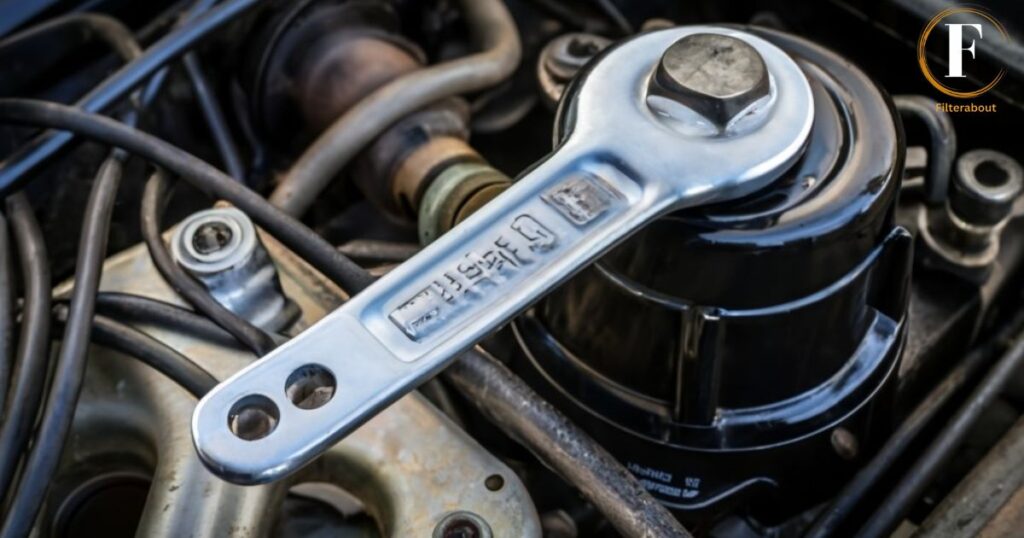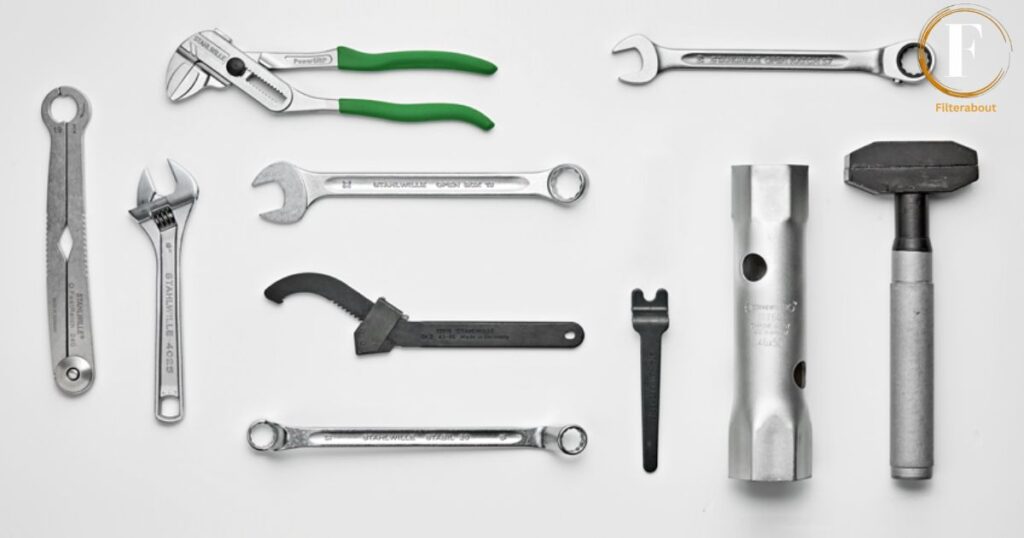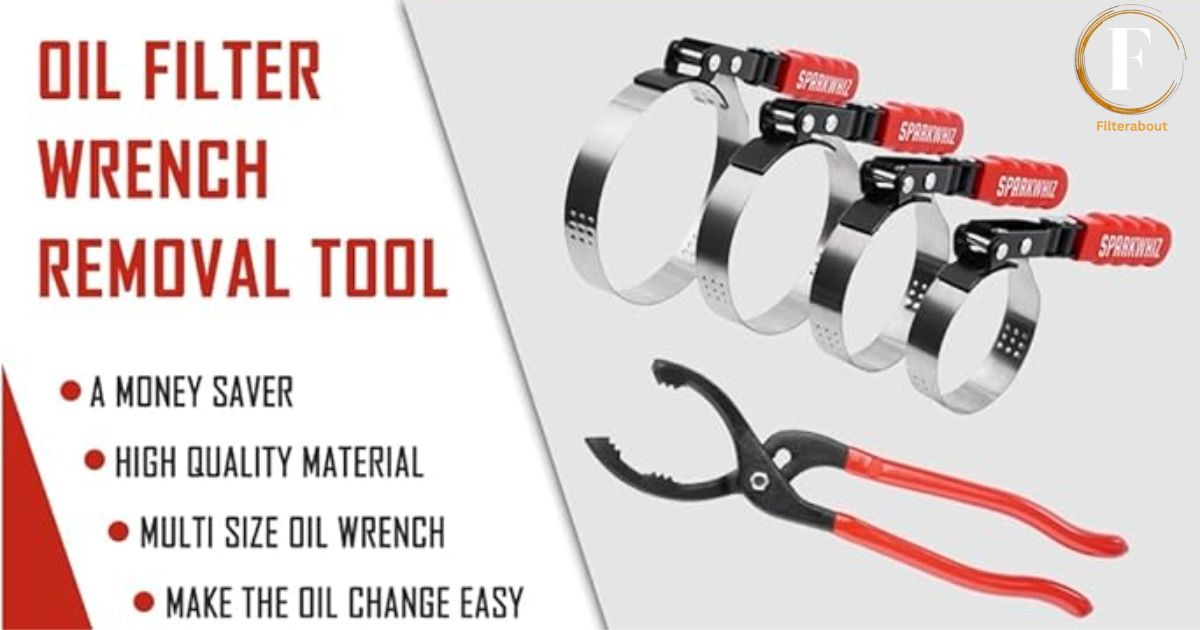An oil filter wrench is a tool used to loosen and tighten the oil filter on a vehicle’s engine. It has an adjustable design that securely grips the filter making it easier to remove or install during routine oil changes.
Start by consulting your vehicle’s manual for specifications. Locate the recommended oil filter size and measure its diameter with a tape measure or calipers. What size oil filter wrench do I need? With this measurement in hand, find the corresponding oil filter wrench. Choosing the right size ensures a snug fit, making the oil change process smooth and hassle-free. Always double-check to avoid this.
To determine the right oil filter wrench size for your car consult the vehicle manual for specifications. Measure the diameter of your oil filter using a tape measure or caliper. Once you have the size, select a matching wrench to ensure a secure fit and smooth removal during oil changes.
Factors Influencing Wrench Size Selection
The appropriate wrench size is crucial for effective and safe use in various applications. The first factor to consider is the size of the fastener or nut being tightened or loosened.
Wrenches come in different sizes to match the corresponding nuts or bolts, and using the wrong size can lead to damage to both the tool and the fastener Don’t Change The Oil Filter Choosing a wrench that fits the fastener snugly is essential to ensure proper engagement and prevent slipping.
The second factor influencing wrench size selection is the type of wrench required for the task. Different wrenches serve specific purposes, such as combination wrenches adjustable wrenches, or socket wrenches.
Each type has its advantages and is suitable for different applications. For instance, a socket wrench with interchangeable sockets provides versatility for various fastener sizes while a combination wrench offers a double-ended design with different sizes on each end.
The torque requirements of the application play a crucial role in determining the appropriate wrench size. Torque is the amount of force needed to tighten or loosen a fastener to the specified level.
Using a wrench that does not match the required torque may result in under-tightening or over-tightening, affecting the integrity of the connection. It’s essential to consult the manufacturer’s specifications or guidelines to ensure the correct wrench size and torque are applied for a given task promoting efficiency and preventing potential damage.
Common Oil Filter Wrench Designs

| Step | Design Aspect | Description |
| 1 | Strap Style | Features a flexible strap tightened around filter |
| 2 | Claw Style | Utilizes adjustable metal claws to grip filter |
| 3 | Socket Style | Resembles a socket with specific filter size |
| 4 | Pliers Style | Functions like pliers with adjustable jaws |
| 5 | Cap Style | Fits over the end of the filter like a cap |
| 6 | Chain Style | Utilizes a chain looped around the filter |
| 7 | Swivel Grip Style | Has a swiveling handle for tight space access |
| 8 | Adjustable Band Style | Employs a band with an adjustable locking mechanism |
Choosing the Right Size Wrench
When selecting the right size wrench for a task it’s crucial to match the tool to the specific job at hand. Wrenches come in various sizes typically measured in metric and imperial units. To choose the correct size first identify the size of the nut or bolt you’ll be working with.
This can be done by using a measuring tool or consulting the equipment’s specifications. Once you know the size, select a wrench that corresponds to it. Using the wrong-sized wrench can damage both the tool and the hardware.
When dealing with tasks such as changing an oil filter, a specialized tool known as an Oil Filter Wrench may be necessary. Oil filters often come in different sizes, and an Oil Filter Wrench is designed to fit these filters precisely. It typically has an adjustable band or teeth that grip onto the filter, providing a secure grip for removal.
Before you try to change an oil filter, please make sure you have the right size of Oil Filter Wrench for the specific filter on your vehicle. This will make the process smoother and help prevent any potential damage to the filter housing.
In addition to choosing the right size wrench, it’s essential to consider the type of wrench that best suits the task. Common types include open-end wrenches, combination wrenches, and adjustable wrenches. Each type has its advantages, so understanding the nature of the job and the available space can aid in making the most effective choice.
Whether it’s a standard wrench for general use or a specialized tool like an Oil Filter Wrench, selecting the appropriate size and type ensures a safer and more efficient completion of mechanical tasks.
Pros and Cons of Different Wrench Types

- Adjustable Wrenches: These tools offer versatility as they can accommodate various nut and bolt sizes. However, their drawback is the potential for jaw slippage during heavy-duty applications.
- Box-End Wrenches: Known for providing a secure grip on fasteners, box-end wrenches are ideal for tight spaces. Nevertheless, they may struggle with rounded-off nuts.
- Open-End Wrenches: Quick to use, open-end wrenches lack the secure grip of other types and can potentially damage fasteners due to their limited contact points.
- Combination Wrenches: Combining the advantages of both open-end and box-end wrenches, this type offers flexibility and a secure grip. However, their dual design may restrict access in confined spaces.
- Socket Wrenches: Excelling at torque application, socket wrenches come in various sizes. Yet, they can be cumbersome and may not fit certain bolt types.
- Pipe Wrenches: Ideal for gripping pipes, these wrenches may damage softer materials and lack precision, making them less suitable for general applications.
- Conclusion: The choice of wrench type depends on the specific task at hand and involves considering the trade-off between versatility and specialized functionality, ensuring the right tool is selected for the job.
Tips for Proper Oil Filter Wrench Usage
When it comes to maintaining your vehicle, proper oil filter wrench usage is essential for a smooth and efficient oil change. An oil filter wrench is a specialized tool designed to grip and loosen the oil filter housing allowing for easy removal and replacement.
To ensure optimal performance it’s crucial to select the right size of the wrench that matches your specific oil filter. Using the correct tool prevents damage to the filter housing and makes the entire oil change process quicker and more effective.
One key tip for using an Oil Filter Wrench is to apply steady and even pressure during operation. Avoid using excessive force, as it may lead to slippage or damage to the oil filter housing. Before using the wrench make sure the engine is off and the oil has had sufficient time to cool down to avoid burns.
A quick inspection of the oil filter wrench for any signs of wear or damage is recommended before each use. Regular maintenance of your tools ensures their longevity and effectiveness.
Always turn the Oil Filter Wrench counterclockwise to loosen the oil filter housing. This standard direction ensures consistency and reduces the risk of confusion during the oil change process. Once the oil filter is loosened it can be easily removed by hand.
After installing the new filter use the wrench to tighten the housing securely but be cautious not to overtighten as it may lead to difficulty in future removal. Following these simple tips for proper oil filter wrench usage will contribute to a hassle-free and efficient maintenance routine for your vehicle.
Care of Oil Filter Wrenches

Taking care of oil filter wrenches is essential to ensure their longevity and effectiveness in automotive maintenance. Firstly, it’s crucial to keep the wrench clean after each use.
Oil and debris can accumulate on the tool, potentially leading to corrosion or difficulty in handling. Wiping the wrench with a clean cloth and, if necessary using a degreaser helps prevent the build-up of contaminants.
Proper storage is key to maintaining the integrity of oil filter wrenches. Storing them in a dry and cool environment prevents rust and corrosion. Hanging the wrenches on pegs or hooks in a tool cabinet is a good practice as it not only saves space but also keeps them easily accessible while minimizing the risk of damage.
Inspect the wrench regularly for any signs of wear or damage. Check for bent or cracked components, and ensure that the adjustment mechanism is functioning smoothly.
If any issues are detected, it’s advisable to replace or repair the wrench promptly to avoid complications during use. By following these simple care practices, one can extend the life of oil filter wrenches and maintain their efficiency in automotive maintenance tasks.
Frequently Asked Questions
What size socket do I need to change my oil filter?
To determine the size for your oil filter consult your vehicle’s manual or use a 14mm or 15mm socket.
What size is the oil filter spanner?
Oil filter spanner sizes vary commonly ranging from 65mm to 93mm. Refer to your specific filter’s documentation for accurate sizing.
Are oil filters standard size?
Oil filters come in various sizes and types and there is no universal standard size. Always check your vehicle’s specifications for the correct filter size.
Conclusion
Determining the appropriate oil filter wrench size is crucial for a smooth and efficient oil change process. Selecting the right tool ensures a secure grip on the oil filter, preventing slippage and potential damage. The correct size prevents frustration and potential delays during routine maintenance, contributing to a hassle-free experience for both DIY enthusiasts and professional mechanics alike.
Whether working on a small sedan or a larger vehicle, understand What Size Oil Filter Wrench Do I Need? Is a fundamental aspect of proper automotive care it’s essential to consult the vehicle’s manual or use an online tool to identify the exact size required for the specific make and model by investing in the correct oil filter wrench size, individuals can streamline their maintenance routines and enhance the longevity of their engines. Always prioritize precision for a seamless and effective oil filter replacement.

Alexander Quinn is the author behind Filterabout.com. Known for expertise in diverse topics, Quinn’s content on the website reflects a versatile knowledge base catering to various interests.



![Jynxzi Age, Net Worth, Career[2024]](https://filterabout.com/wp-content/uploads/2024/05/Who-Is-Shanin-Blake-Age-Wiki-Parents-Dating-Net-Worth-300x148.jpg)
![Jynxzi Age, Net Worth, Career[2024]](https://filterabout.com/wp-content/uploads/2024/05/Jynxzi-Age-Net-Worth-Career2024-300x148.jpg)


![Kutty Surumi Net Worth, Bio, Age[2024]](https://filterabout.com/wp-content/uploads/2024/05/Kutty-Surumi-Net-Worth-Bio-Age2024-300x148.jpg)



![Jynxzi Age, Net Worth, Career[2024]](https://filterabout.com/wp-content/uploads/2024/05/Who-Is-Shanin-Blake-Age-Wiki-Parents-Dating-Net-Worth-150x150.jpg)